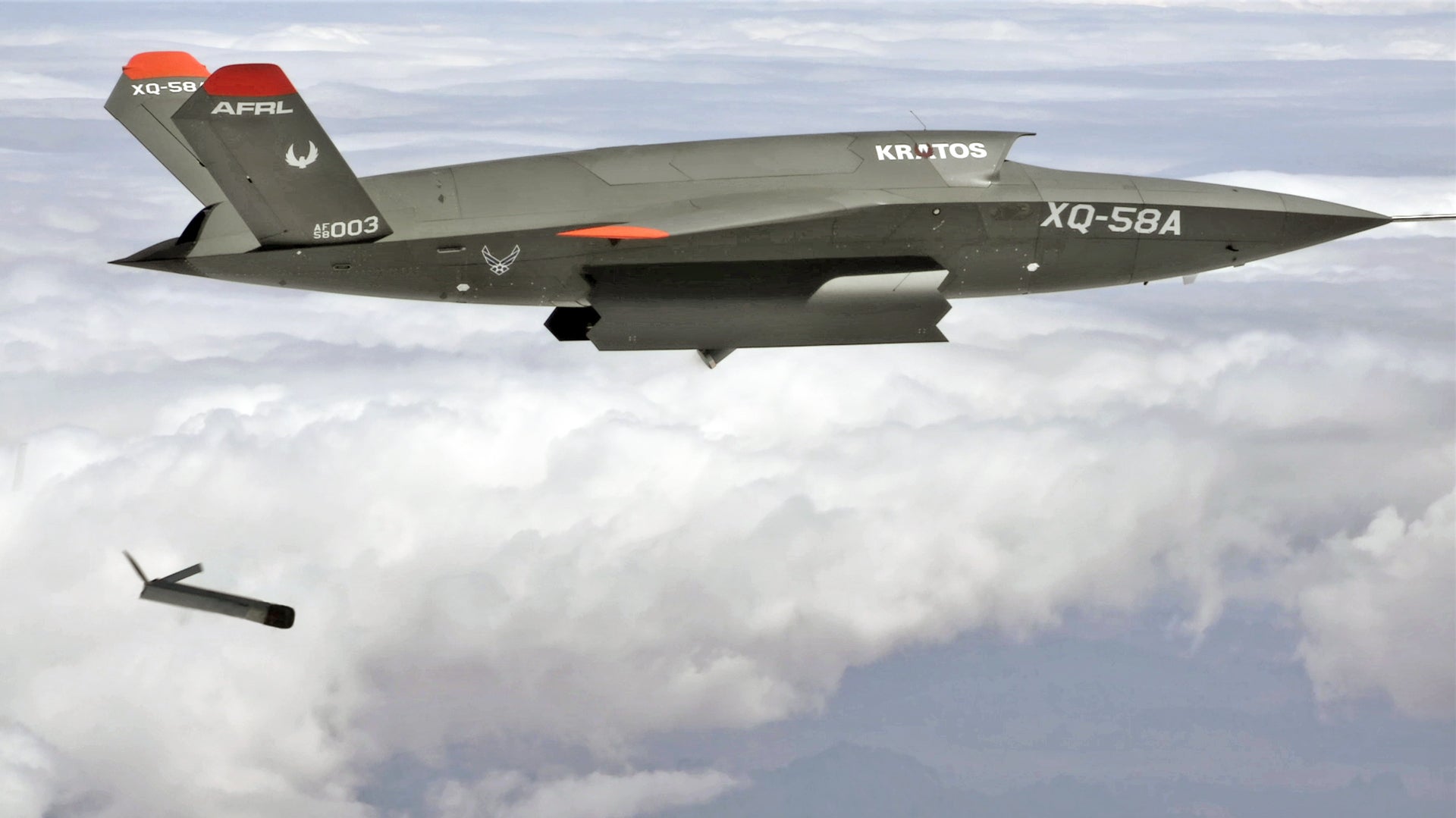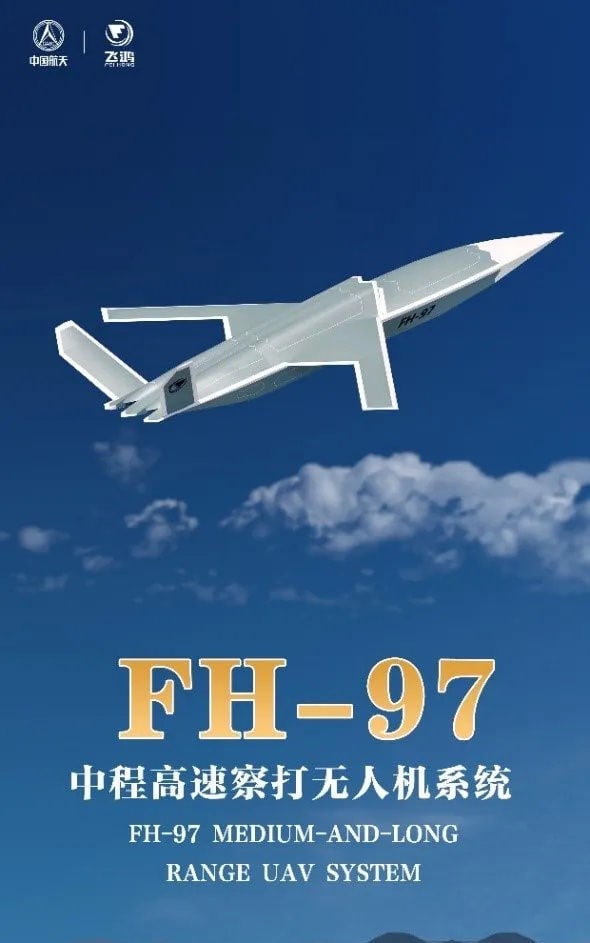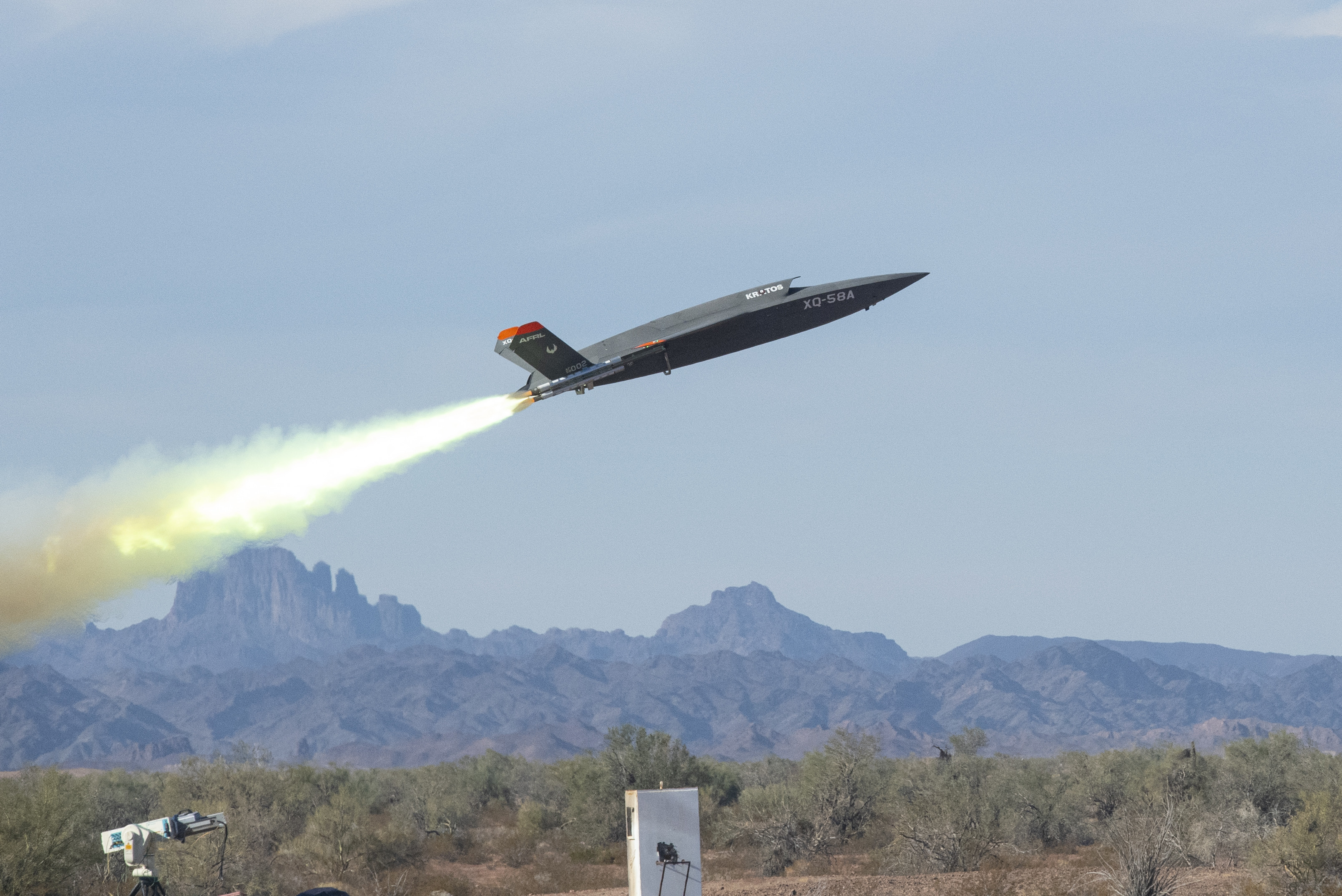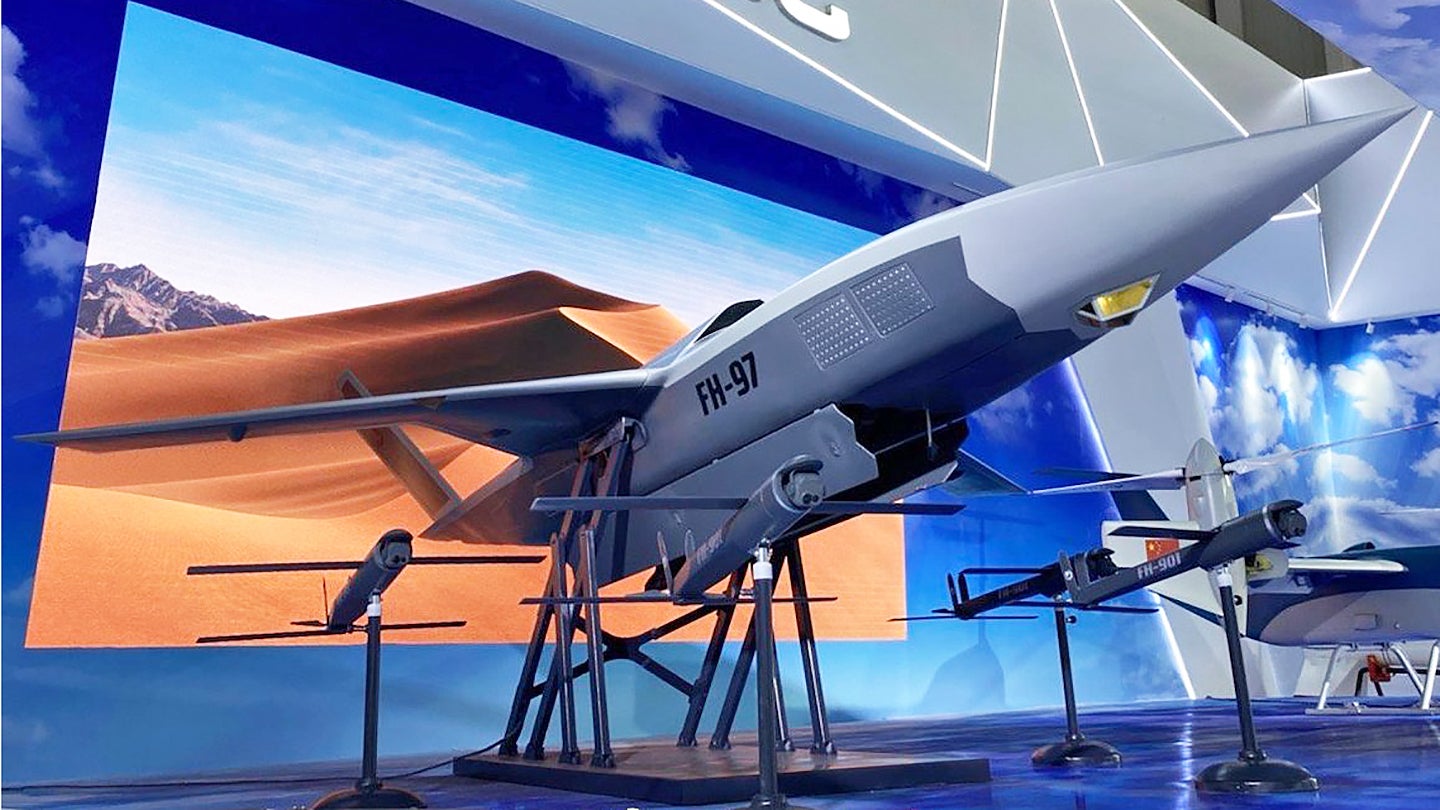Another new Chinese drone development has caught the eye of experts and observers at the country’s big international airshow in Zhuhai, which began officially today. Known as the FH-97, it looks for all intents and purposes, like a clone of the XQ-58A Valkyrie, the stealthy, affordable unmanned aircraft that has been developed by U.S. drone-maker Kratos.
The Chinese FH-97 drone, which is being offered by China Aerospace Science and Technology Corporation, or CASC, would seem to have been tailored to fulfill the same kinds of combat roles as envisaged for the Valkyrie, which is being developed for the U.S. Air Force as the centerpiece of its work on unmanned attritable platforms — drones that are low-cost yet still survivable enough that they can be employed in high-risk situations that might preclude the use of a more costly asset.
The FH-97 was revealed at Zhuhai in the form of a mock-up on the CASC stand, one of a number of drones of different sizes being marketed by the company. Like the Valkyrie, the Chinese FH-97 features a stealthy trapezoidal fuselage, sharply swept main wings, a V-shaped tail, and an air intake located above the fuselage. Even the fuselage weapons bay features the same stealthy serrated edges to its doors, although the Chinese drone features an electro-optical sensor in a stealthy gold-plated windowed enclosure below the nose, similar in broad appearance to the one found on the F-35 and, to an extent, the J-20. It also features two small jet engines, instead of one. This is not too surprising considering what we understand about the limitations of China’s indigenous jet engine manufacturing capabilities.

While official promotional material for the FH-97 describes it only as a “medium- and long-range UAV system,” it has also been identified by observers as a reconnaissance and attack UAV system, which would seem to be accurate. It is being offered as part of a new Feihong (FH) series of drones, which also includes the FH-95 multifunctional UAV driven by a pusher propeller, an unmanned helicopter with a conventional main rotor plus two propellers for forward flight, and the FH-901 loitering missile, apparently previously known as the CH-901. The latter appears to be heavily influenced by loitering munitions like the AeroVironment Switchblade.
While we are yet to see specifications for the FH-97, it does appear to be similar in dimensions to the XQ-58A, which is 30 feet long, has a wingspan of 27 feet, and a maximum takeoff weight of 6,000 pounds. While China has been accused of copying Western designs in the past, and the FH-97 does look remarkably similar to the Valkyrie, it’s also worth noting that India, too, has opted for a very similar design approach for its own loyal wingman drone, the HAL Combat Air Teaming System (CATS). Russia’s “Grom” is also very similar, as well, among others.
The new Chinese Feihong drones, although apparently not on display in finished form, are part of an interesting array of other equipment at Zhuhai, including the J-16D electronic attack jet, shown with jamming pods for the first time, as well as another CASC product, the CH-6 long-endurance, twin-jet multirole drone, seen for the first time in a full-size form.
What makes the FH-97 especially interesting is that it suggests strongly that China is following the path now being taken by the U.S. Air Force, and increasingly by other air forces, too, toward fielding a stealthy, attritable drone, optimized for flying more hazardous sorties, including strike, electronic warfare, or intelligence, surveillance, and reconnaissance (ISR), within contested airspace.
In addition, when coupled with parallel developments in artificial intelligence, these same kinds of drones are also expected to work as loyal wingmen in direct support of manned aircraft, or as networked swarms for a range of missions, including air-to-air combat. It is widely understood that China is already working to flight test an AI computer ‘brain’ similar to how the U.S. is executing its own Skyborg initiative. This testing could support future loyal wingmen endeavors, but really you don’t need AI for this capability. A semi-autonomous control interface from the cockpit of a manned combat aircraft within line of sight of the loyal wingman drones will provide a perfectly acceptable concept of operations and overall combat capability.
With this in mind, China is also showcasing its concept for a two-seat variant of its J-20 stealthy heavy fighter. The second seat would be highly relevant for a mission controller directing unmanned aircraft and taking care of the overall tactical ‘picture.’ Similar capabilities are being eyed for two-seat American fighters equipped with wide-area displays, such as the F-15EX.
Showing the FH-97 alongside the FH-901/CH-901 also raises the possibility that the larger drone may be intended to launch smaller UAVs of its own, paralleling the kinds of tests that are underway in the United States involving the XQ-58A, as well as the smaller Airwolf, also from Kratos. The ability to air-launch stores beyond the kinds of offensive munitions usually associated with strike drones would offer considerably more versatility. These smaller drones could be used for kinetic strikes, to collect intelligence remotely, or, maybe most importantly, to provide stand-in electronic warfare support.

Based on the model and the artworks of the FH-97 seen so far, it’s not immediately clear how it is supposed to be launched or recovered, although there would appear to be internal space for conventional wheeled landing gear. However, as far as the XQ-58A is concerned, its main focus is being runway independent—taking off via rocket assistance and landing via a parachute—making it more suitable for distributed operations, in theaters where access to conventional runways may not be guaranteed.

Kratos has also shown a model of a launch system for the Valkyrie that can be accommodated inside a standard shipping container, which could also be an option for the Chinese drone. Regardless, a capable jet-powered combat drone that is runway independent would drastically increase the possible locations from which the PLAAF could project power during a major conflict and wildly complicate its foe’s defensive plans. It could also provide relevant air combat punch over substantial ranges, even from mainland China, without relying on vulnerable runways and other infrastructure to do so.
China has been notably active in the unmanned aerial vehicle field for some time now, producing a succession of drones of all kinds for both domestic use and for export. With that in mind, it may well be that the FH-97 is aimed at foreign customers as well as for the People’s Liberation Army, with CASC identifying burgeoning interest for this class of drone, based on the ongoing interest in the XQ-58A program. Moreover, the appearance of the FH-97 confirms that China, too, is at least considering the options presented by a class of drone that is both stealthy and that could have a low-cost point built-in from the outset. This would be in addition to China’s many traditional higher-end stealthy unmanned aircraft programs.
Above all, a stealthy yet attritable multirole drone like the FH-97 would fit with what we already know about China’s efforts to rapidly enhance its unmanned capabilities across the board, including the development of manned-unmanned teaming and optionally manned air combat concepts. Drones like the FH-97 also bring the potential for rapidly increasing air combat ‘mass,’ with the aim of overwhelming an enemy by using significant numbers of drones, as well as payloads and tactics that are intended to overwhelm or confuse hostile air defenses. A possible Chinese invasion of Taiwan, for instance, is just one example of the kind of scenario in which drones of this kind could be of extreme value.
The Chinese inventory now boasts everything from long-endurance, medium-altitude, propeller-powered surveillance types, to more advanced high-altitude, long-endurance intelligence-gathering jet-powered drones, and even rocket-propelled high-speed reconnaissance drones. However it’s intended to be used, the FH-97 provides yet another piece in the Chinese aerial drone puzzle, one that could quickly become a top priority within China’s increasingly complex unmanned military aircraft ecosystem. Of course, could is the operative term here as we don’t know at this time just how far along the FH-97 is in its development.
UPDATE:
We have some conceptual video of the FH-97 in action and yes, the smaller loitering munitions are meant to be launched from its weapons bay:
Contact the author: thomas@thedrive.com
